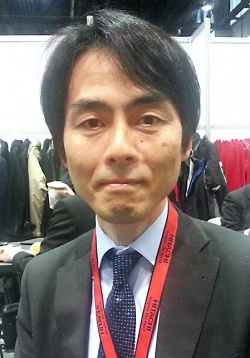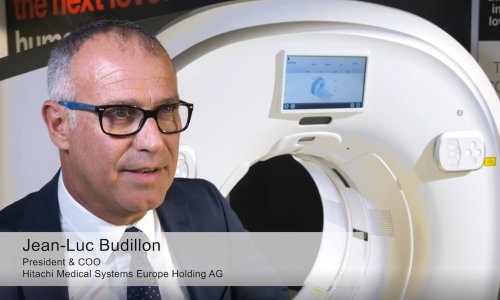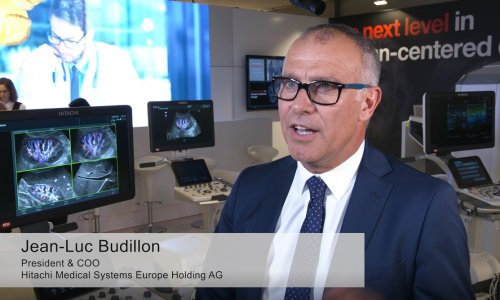Open platform
Hitachi powerfully expands Oasis 1.2T MRI
Hitachi has double-down its bet on the advantages of open-platform MRI by introducing a new generation of the Oasis 1.2T scanner this year at RSNA. The jump to new processing power and the new Origin 4.0 MR Operating Software effectively enhances capabilities with a range of new applications for neuro, orthopedic and vascular imaging as well as enhancing routine exams for women's health and oncology.
Report: John Brosky


Meanwhile, Hitachi has ramped up production facilities to meet a growing demand for the unique open-platform configuration that helps radiology groups meet the challenges posed in imaging children, the disabled, overweight patients or simply anxious patients uncomfortable with claustrophobic conventional scanners. Hitachi expects to increase the availability of the Oasis platform, specifically with a focus on European hospitals and imaging centers.
The first thing you notice about the Oasis 1.2T is the wide, open patient platform, a welcome change from the sliding tables of traditional MRI designs where the patient is pushed into a confining bore. For radiologists, putting at ease these difficult patients means reducing the risk of repeat scans, decreased scan time and a higher quality diagnostic image. "Open Architecture is a truly valued and complementary tool for healthcare providers that have an array of scanners but see this flexibility as an essential requirement for their service offering to patients," said Shawn Warthman, Director for MR Marketing with Hitachi America.
In America today, he said, roughly one in 10 patients arriving for a diagnostic exam are obese and often too difficult to be effectively scanned in closed bore systems. The open gantry and wide table of Oasis that can accommodate all patients independent of their body size and weight appeals to what Warthman called, "a rather large group of customers performing routine exams from large regional medical centers to smaller community hospitals." According to Keiichi Yusa, Vice President and Director of the MR/CT Division for Hitachi Europe, "These patients may be challenging, but they are still patients with medical conditions that require an MRI examination. Oasis allows imaging centers to perform these exams more comfortably and effectively."
At RSNA Hitachi presented the expanded applications available for Oasis 1.2T with the combination of the new Vertex II computer and the Origin 4.0 MR Operating Software. Enhanced computing and processing power with a state-of-the-art 64-bit host computer streamlines the entire imaging process and related workflows from patient registration through scan planning, the scanning operation itself and on to image processing and image management. Expanded clinical capabilities include 3D isotropic acquisitions (isoFSE), combined multi-echo gradient echo imaging, radial imaging combined with parallel acquisition, or ADAGE and RAPID-RADAR, and advancements in non-contrast MRA (VASC-FSE).
According to Warthman neurology imaging benefits greatly with increased power behind motion compensation technique RADAR that is available for any sequence or coil in any plane. The upgraded Oasis 1.2T now features susceptibility weighted imaging (SWI), also called blood-sensitive imaging that plays an important role in neurological exams. Spectroscopy and perfusion are also available for full clinical investigation of neurological patients.
Hitachi has also expanded its portfolio for musculoskeletal examinations by taking full advantage of the open platform architecture to acquire an image radially. While patients may try to hold still during an exam, many will voluntarily or involuntarily move. Spine examinations supported by the flow and motion compensation technique of radial acquisition with RADAR significantly improve image quality and expedite interpretation without constraining or sedating patients.
The limited availability of the early versions of Oasis due to production constraints means that for Europe, the unique platform remains a relatively new scanner, according to Hitachi's Yusa. "The advantage is that we are bringing to European centers state-of-the-art capabilities with upgraded processing power and jumping to the latest features of the version 4 software," he said.
More information on www.hitachi-medical-systems.eu
01.07.2015










